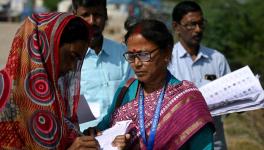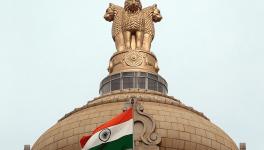Whom Should the President Invite to Form Government?

There are many silences in a written Constitution and it is by convention and precedents that such silences are addressed. One important silence in the Indian Constitution is on the issue of whom the President of India shall invite to be the Prime Minister in case there is no clear mandate.
The party-wise position after the general elections of 2024 throws open such a challenge before the incumbent President. The Election Commission of India’s official website shows the Bharatiya Janata Party (BJP) winning 240 seats and falling 32 seats short of a majority. The second largest party is the Indian National Congress, which has secured 99 seats.
Article 83(2) of the Constitution reads: “The House of the People, unless sooner dissolved, shall continue for five years from the date appointed for its first meeting and no longer and the expiration of the said period of five years shall operate as a dissolution of the House.”
The first meeting of the 17th Lok Sabha was held on June 17, 2019. In the 17 Lok Sabha, the oath-taking session was combined with the budget session. The life of the present Lok Sabha is, therefore, to expire on June 16, 2024, unless the President dissolves it earlier in terms of Article 83(2).
No party has been able to secure a clear majority. Therefore, the question is, whom should the President of India invite to form the government?
India follows the Parliamentary form of government, more specifically known as the Westminster type of government. The House of Commons and House of Lords, the two Houses of the Parliament of the UK, are convened at the Palace of Westminster, hence this name.
The Prime Minister of India, as in the UK, is the de facto head of the government.
Article 52 reads: “There shall be a President of India.”
According to Article 53(1), “The executive power of the Union shall be vested in the President and shall be exercised by him either directly or through officers subordinate to him in accordance with this Constitution.”
The President of India is the de jure executive head and the Prime Minister is the de facto executive head.
Article 74(1) of the Constitution reads: “There shall be a Council of Ministers with the Prime Minister at the head to aid and advise the President who shall, in the exercise of his functions, act in accordance with such advice.”
The Prime Minister is described as ‘primus inter pares’— first among equals and the ‘keystone of the Cabinet arch’.
While the President is to act as per the aid and advice of the Prime Minister, there is one power he is required to exercise in his discretion and that is the power to appoint the Prime Minister in terms of Article 75(1).
According to Article 75(2): “The Ministers shall hold office during the pleasure of the President.” Article 75(3) says, “The Council of Ministers shall be collectively responsible to the House of the People.”
The method of appointment of the Prime Minister is not mentioned in the Constitution and that is a constitutional silence. When there is silence in the written Constitution, we rely on constitutional conventions. Constitutional conventions mean political customs.
With this legal background in mind, let us look at the precedent.
The storm in 1979
The first major challenge before a President of India regarding appointment of a Prime Minister arose in 1979 when there were resignations of Morarji Desai and Charan Singh as the Prime Minister and deputy Prime Minister respectively.
Though President Neelam Sanjiv Reddy initially invited Y.B. Chavan, the then Leader of the Opposition to form a government, he could not get the support of enough members of Parliament.
Subsequently, Charan Singh claimed, as a leader of a group of members of Parliament, of being capable of forming a viable and stable government, so the President invited him to do so.
By the time Charan Singh was supposed to prove his majority through a confidence motion in Lok Sabha, Congress Indira (I) had withdrawn its support and Charan Singh could not prove his majority in the House. Thereafter, the President dissolved the House.
A decade later…
After the general elections in 1989, there was no clear majority in the House for any single political party. The constitutional conventions were also not firmly established by then.
President R. Venkataraman initially invited Rajiv Gandhi, the leader of the largest party, to form the government, though he had not obtained an absolute majority in the House.
In the 17 Lok Sabha, the oath-taking session was combined with the budget session.
After Rajiv Gandhi declined the invitation, V.P. Singh was invited to form the government and asked to prove a majority within 30 days.
More, and soon
In 1990, V.P. Singh lost the majority in the House after the withdrawal of support by the BJP and the President once again invited Rajiv Gandhi to form the government.
Rajiv Gandhi declined the invitation and offered his unconditional support to Chandra Shekhar. The President invited Chandra Shekhar and he accepted the invitation and became the Prime Minister.
The coalition era
After the general elections of 1996, three Prime Ministers were appointed by two Presidents. They were:
- Atal Bihari Vajpayee, who was invited by President Shankar Dayal Sharma, who could not prove his majority within the time granted by the President and who resigned within thirteen days in office.
- H.D. Deve Gowda, who was sworn in as Prime Minister on June 1, 1996 by the same President Shankar Dayal Sharma. Gowda subsequently (on April 11, 1997) lost the support of the Congress party and resigned.
- President Sharma then appointed I.K. Gujral as the Prime Minister on April 21, 1997, and asked him to prove a majority within two days.
- On November 28, 1997, the Congress party withdrew support from the Gujral government. Since the constituents of the United Front had informed the President that they would support neither a Congress nor a BJP government, the President dissolved the House.
Vajpayee’s twists and tosses
The then President K.R. Narayanan, while inviting BJP leader A.B. Vajpayee, with 182 seats (the largest single party), wanted to know whether he would be able to form a stable government. The President insisted on documentary proof of support.
Vajpayee was sworn in as Prime Minister for the second time on March 19, 1998, and won a vote of confidence in Lok Sabha on March 28, 1998.
Vajpayee lost a vote of confidence a year later, when All India Anna Dravida Munnetra Kazhagam (AIADMK) supremo J. Jayalalithaa withdrew her support.
The President was convinced that a stable government could not be formed and he conveyed it to the Prime Minister before dissolving the House.
Later, when President K.R. Narayanan invited Vajpayee on October 11, 1999 to form the government, he was not asked to prove the numbers as the National Democratic Alliance (NDA) had won 296 seats in the 538-member House.
Manmohan Singh’s appointment by President Dr A.P.J. Abdul Kalam
This was comparatively without much difficulty as the President himself was satisfied about the majority of Congress-led government in the 14th Lok Sabha.
Past precedents point out certain important aspects of selection. The President has discretion while inviting the leader to be sworn in as the Prime Minister. The consideration for such an invitation is the judgment of the President that he is most likely to command a majority in the House.
It would be instructive to reread President K.R. Narayanan’s communique of March 1998: “When no party or pre-election alliance of parties is in a clear majority, the Head of State has in India or elsewhere given the first opportunity to the leader of the party or combination of parties that have won the largest number of seats subject to the Prime Minister so appointed obtaining majority support on the floor of the House within a stipulated time.
“This procedure is not, however, an all-time formula because situations can arise where members of Parliament not belonging to the single largest party or combination can, as a collective entity, out-number the single largest claimant. The President’s choice of Prime Minister is pivoted on the ‘would be’ Prime Minister’s claim of commanding majority support.”
Example from UK
Since India follows the Westminster type of government, it is not out of place to take a cue from the practice in the UK.
UK Prime Minister Theresa May called a general election in 2017. But her party, the Conservatives, could win only 318 seats, short of the 325 mark in a 650-member House.
The President of India is the de jure executive head and the Prime Minister is the de facto executive head.
Together with the support of 10 members of Parliament from the Democratic Unionist Party (DUP) on key votes, Theresa May continued to hold office as the Prime Minister of the UK. It may be noted that the Conservatives and the DUP were not in a coalition.
When ministers are from both the parties and they agree on a joint programme, it is called a coalition government. The Conservatives and the DUP agreed to a “confidence and supply” agreement, reported the BBC.
Something similar could happen in India for the formation of a coalition government or a government with outside support in June 2024.
The method of appointment of the Prime Minister is not mentioned in the Constitution and that is a constitutional silence.
Hope the President, in her wisdom, will follow the rich traditions set by her illustrious predecessor, K.R. Narayanan and take inspiration from the Westminster practice.
Prashant Padmanabhan is an Advocate-on-Record of the Supreme Court of India. He can be reached at [email protected].
Get the latest reports & analysis with people's perspective on Protests, movements & deep analytical videos, discussions of the current affairs in your Telegram app. Subscribe to NewsClick's Telegram channel & get Real-Time updates on stories, as they get published on our website.






















